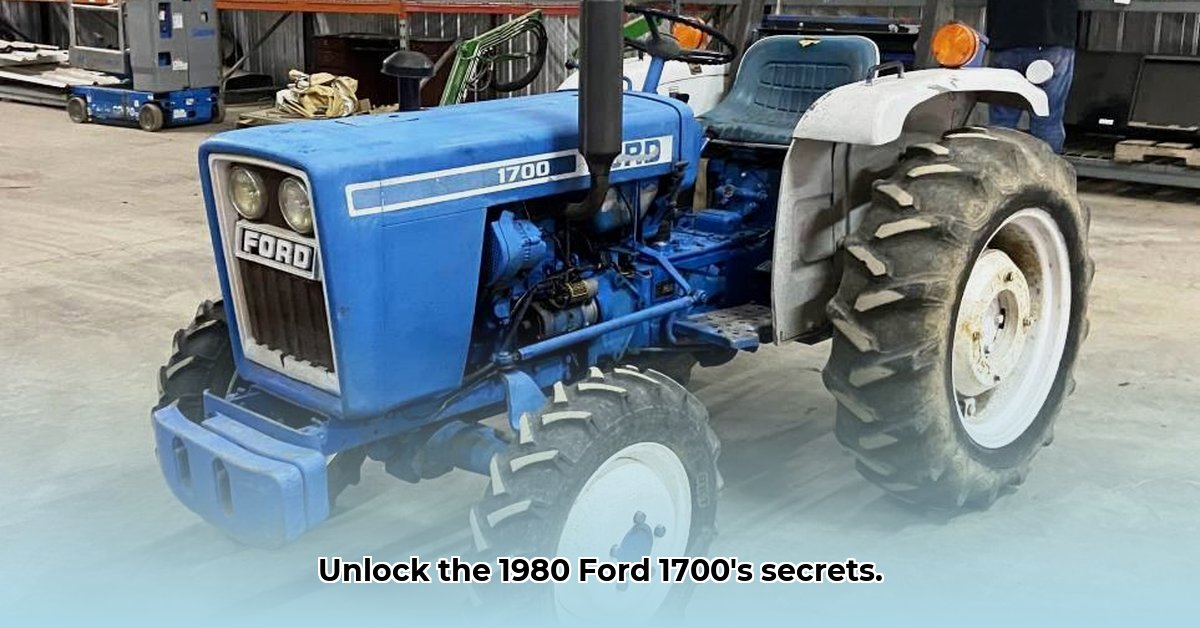
The 1980 Ford 1700, a compact tractor built by Shibaura Manufacturing Company for Ford, represents a blend of Japanese engineering and American marketing. This guide provides a comprehensive overview of its specifications, history, and restoration, catering to both seasoned mechanics and curious enthusiasts. We’ll explore its capabilities and offer practical advice for maintaining this classic workhorse. Are you ready to delve into the details of this dependable vintage machine?
Engine and Power: The Heart of the 1700
The 1980 Ford 1700 boasts a robust two-cylinder diesel engine. While its gross horsepower output is modest (approximately 25 hp), its reputation for reliability is well-earned. This power, perfectly suited for smaller farms and various tasks, is a testament to the tractor's simple yet effective design. Many of these tractors are still operational today, highlighting their exceptional build quality. Isn't it remarkable that a tractor from this era continues to perform effectively?
Transmission and Drivetrain: Smooth Shifting and Versatility
This compact tractor features a smooth 12-speed forward and 4-speed reverse transmission. This versatile setup allows for optimal performance across different terrains and speeds. While precise details on variations are limited, some believe minor differences in wheelbase existed, potentially linked to 2-wheel or 4-wheel drive configurations. Further research is needed to definitively confirm these variations. How did this simple yet effective transmission system contribute to the tractor's overall popularity?
Size and Weight: Maneuverability and Compact Design
Precise dimensions, particularly the wheelbase, remain challenging to pinpoint definitively due to potential variations in tires and wheels. However, its compact size is a key characteristic. This nimbleness is perfect for smaller properties and navigating tight spaces. This agility, rare in larger tractors, made it uniquely suitable for a variety of applications. How did this compact size impact its market appeal?
Attachments and Adaptability: Expanding the Tractor's Utility
The Ford 1700's adaptability is a significant highlight. Its design allows for easy attachment of various implements. Consider the possibilities: front-end loaders for materials handling, mower decks for lawn maintenance, snowblowers for winter use, or even backhoes for digging. This versatility was a significant selling point that made it ideal for numerous tasks. What other attachments could a diligent owner add to increase the 1700’s overall utility?
Cost and Value: Then and Now
In 1982, the estimated price of a new 1980 Ford 1700 was approximately $7,353 (adjusted for inflation, this represents a substantially higher value today). That price point made it significantly more affordable than its larger counterparts, thereby increasing its accessibility. Today, collector value depends greatly on the tractor's condition and the availability of replacement parts. What factors contribute to the fluctuating value of a vintage Ford 1700 today?
Maintenance and Parts: Ensuring Long-Term Functionality
Maintaining your vintage Ford 1700 requires diligent care and forethought. Parts availability is a critical issue. While some components are readily accessible, others might prove challenging to locate. Regular maintenance, including frequent oil changes and careful inspections, is vital for longevity. What strategies can owners employ to mitigate the challenges of finding replacement parts for this vintage tractor?
Restoring Your Ford 1700: A Step-by-Step Guide
Restoring a Ford 1700 is a rewarding project. This guide outlines a practical approach:
- Assessment: Evaluate the tractor's condition to determine the scope of the restoration.
- Disassembly and Cleaning: Thoroughly clean and disassemble components for individual restoration.
- Engine and Mechanical Restoration: Address mechanical issues; engine rebuilds may require professional assistance.
- Transmission and Hydraulics: Inspect and repair or replace faulty transmission and hydraulic components.
- Cosmetic Restoration: Decide on an aesthetic approach (preserving patina or repainting).
- Reassembly and Testing: Carefully reassemble the tractor and thoroughly test all systems.
Remember, sourcing parts may require creative strategies, and careful budgeting is essential. What is the most critical step in ensuring a successful restoration project?
Summary of 1980 Ford 1700 Tractor Specs:
| Specification | Details | Additional Notes |
|---|---|---|
| Manufacturer | Ford (built by Shibaura) | A collaboration between American marketing and Japanese engineering. |
| Engine | 2-cylinder Diesel | Approximately 25 gross horsepower; known for its reliability. |
| Transmission | 12 Forward / 4 Reverse Gears | Smooth shifting; offers versatility for diverse tasks. |
| Attachments | Mower deck, snowblower, loader, backhoe | Highly adaptable, expanding its usability considerably. |
| Original Price (1982) | Approximately $7,353 | Considerably less than larger tractors of the time. |
| Production Years | 1979-1983 (approximately) | A limited production run; potentially increasing its collector value. |
This guide provides a comprehensive overview of the 1980 Ford 1700. Remember that specific details may vary. Always verify information from multiple sources before making any decisions.